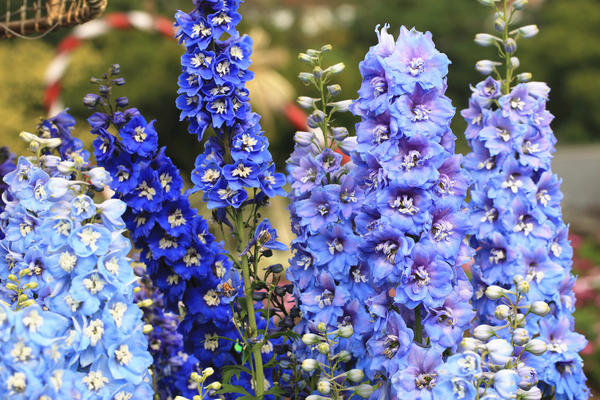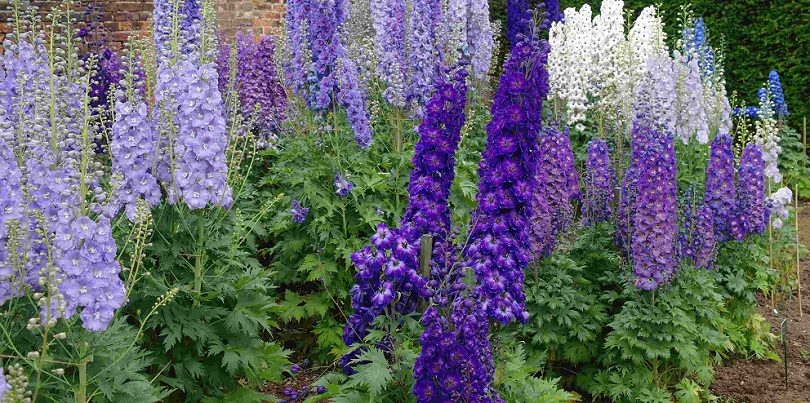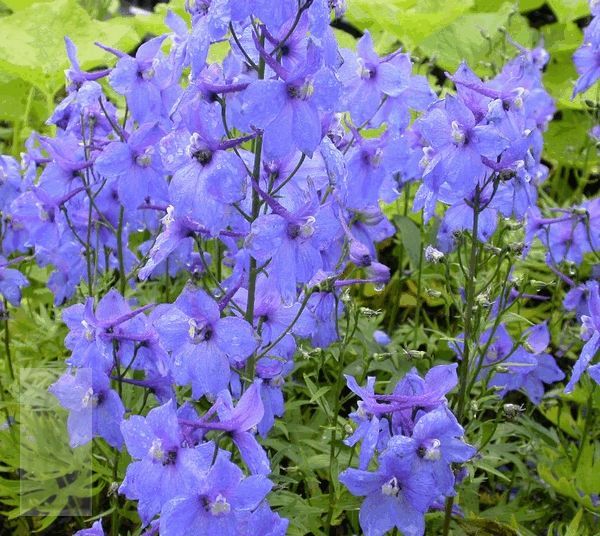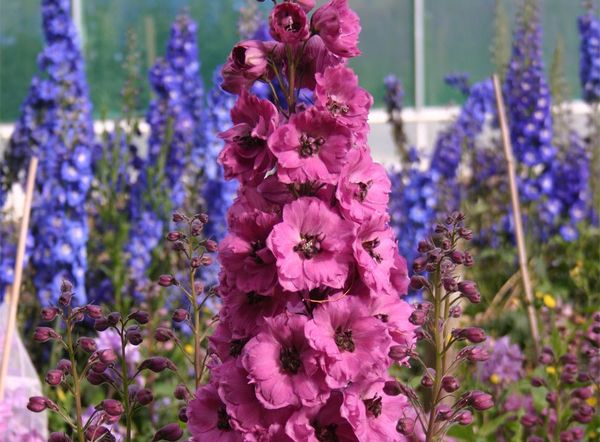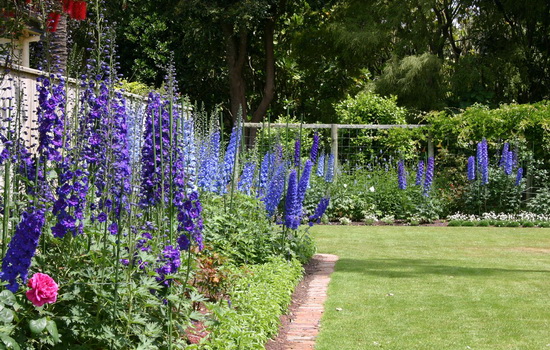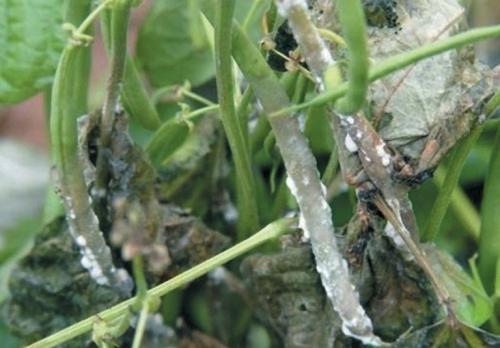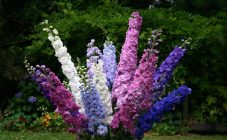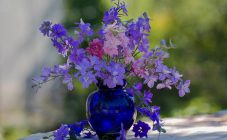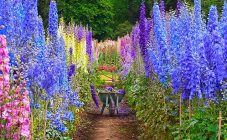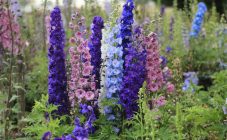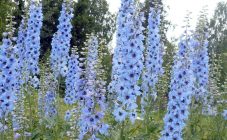Content:
Delphinium is an annual or perennial herb with numerous flowers arranged along a tall stem that reaches more than 2 m in height. Flowers belong to the Buttercup family, a close genus of the Aconite.
Plants of this botanical group contain in all their parts poisonous compounds - alkaloids. Plants containing alkaloids can be both medicinal and poisonous. Whether a delphinium is poisonous or not depends on the interaction with the plant, poisoning can occur when various parts of it enter the stomach, and contact with leaves and flowers can cause allergic reactions. In general, the delphinium is not dangerous to humans.
Everything about the delphinium says a large species diversity and a wide geography of distribution since ancient times. On the territory of Russia, mainly annual species of field burgundy and its related genus, called Sokirki, grow. In gardens, only selective plant hybrids are often grown.
The Latin botanical name for the flower is delphinium, it happened, according to various sources, because of the similarity of the unopened buds with the body of a dolphin or because of the ancient place of growth - the Greek city of Delphi.
The popular Russian name - larkspur, was given due to the medicinal properties of the plant, the herb of which was used for bone fractures. The flower was called the spur because of the way the flowers of the delphinium look, and the presence of the spur structural element on the flowers.
For medical or other purposes, the cultivation of burgers is limited, the main purpose of cultivation is decorative.
Plant characteristic
Description of the plant delphinium:
- The stem is straight, hollow, breaks easily, tall species require a garter. The height in dwarf species is from 10 to 40 cm, in tall ones - up to 2 m, in forest species - it can reach 3 m.
- Leaves are dissected, with serrated and serrated edges, wedge-shaped or multi-faceted, often pubescent. The leaves are colored, depending on the flowers: flowers in dark shades have brown or reddish leaves, while light flowers have green leaves. The leaves are arranged on the stem alternately, their number depends on the type of delphinium and the quality of the soil. On well-fertilized soils, leaves grow three times more than on depleted soils.
- Flower - simple, semi-double or double, forms adapted for pollination by bumblebees and hummingbirds. The color of flowers is blue or purple, in cultivated forms there is also a white color or with shades of pink. Delphinium flowers are formed in paniculate or pyramidal inflorescences of different densities. The size of the flower is from two to eight centimeters, depending on the species. The number of flowers in an inflorescence can be from 50 to 80 pieces, flowers are located on half of the stem.
- Seeds are black, with three sides, small, up to 800 seeds can be obtained from one inflorescence. The seeds are in the fruit - leaflet, there are usually three of them in each flower, or about eight in a semi-double flower. Seed germination is preserved during storage for 3-4 years, and in the refrigerator, their shelf life is not limited.
- The root system is racemose, without a dominant root, with many adventitious. The rhizome, depending on the growing conditions, can develop into a stem root.
- Flowering - for annual species: from mid-summer to autumn, for perennials - about three weeks in early summer. Perennials bloom for 5-7 years.
- Reproduction - by seeds, cuttings, dividing the bush.
As the flowers that look like delphiniums are called, these are ornamental plants that also resemble slender conical candles in their flowering: lupine, liatris, eremurs.
Species characteristics
In horticulture, annual, perennial and hybrid species of delphinium larkspur flowers are used.
Annual plants:
- Field delphinium is a bush, up to 2 meters high, with dissected leaves and loose inflorescences, the length of which is about 30 cm. It has been grown in gardens since 1575. Inflorescences of different colors: blue with a white center, dark blue, pale pink. Flowers are grown for the purpose of cutting. Spectacular varieties: Frosted Sky, Qis Dark Blue, Qis Rose.
- Delphinium Ajax - has been cultivated for several centuries, dwarf forms grow, from 20 cm to a maximum height of 1 m. A species that originated from the crossing of a dubious and eastern delphinium. Leaves with a strong dissection, hyacinth-like flowers, up to 5 cm in size, double with dense inflorescences. Some of the latest cultural forms are pink, crimson, purple and white.
Perennial plants are divided into groups:
- eurasian;
- American;
- African.
Hybrid, united in the cultural delphinium group:
- Belladonna is a rare species with paniculate inflorescences with heavily dissected leaves. The stem is up to 80 cm long, with blue, purple flowers, with yellow and black eyes, as well as a delphinium that has a completely snow-white flower. Varieties: Casa Blanca, Capri, Lamartine, Piccolo.
- Pacific - includes 12 varieties of American origin, which are suitable only for warm climates, because they are weakly frost-resistant. The varieties are distinguished by a powerful tall stem, with dense pyramidal inflorescences up to 1 m in length. The flowers are large, semi-double.
- New Zealand - breeder of the group - T. Daudswell, who made a breakthrough in floriculture, he brought out outstanding decorative varieties of delphinium. Large luxurious semi-double and double flowers adorn, including shortened stems, which increases the plant's resistance. Group varieties: Royal Aspirations, Green Twist, Dusky Maydens, Innocence, Mysty Mauves.
- Elatum - breeder of the group - K. Foster, bred tall delphiniums, which differ only in blue or blue flowers, collected in pyramidal inflorescences. Delphinium flowers are usually large, simple and semi-double in shape. Varieties: Ariel, Malvine, Persival
- Marfinsky is a Russian selection that was produced from 1949 to 1992. Plants with increased frost resistance and semi-double flowers with excellent decorative effect. Stems, about 180 cm high, pyramidal brushes. Some varieties of the series: Blue lace, Memory of Faith, Lavender obelisk, Lilac spiral, Tenderness.
Features of agricultural technology
The delphinium is planted through seedlings and by direct sowing of the seed into open ground. Delphinium is planted in spring, at the beginning of April, but you can sow it before winter.
Purchased delphinium seeds are considered quite capricious and often show poor germination, so it is most favorable to collect your own seeds or dress them before planting.
The place for growing is chosen illuminated, but with the possibility of light shading from the bright midday sun, otherwise the color of the flowers begins to fade quickly. When determining the correct planting site, it is important to know that the plant does not tolerate transplantation due to its structural features.
The hollow stem breaks off easily, so the growing area must be protected from the wind.
Soils with high acidity are not suitable for planting delphiniums.The spur will grow well in sandy loam and loamy highly fertile soils with moderate moisture. Acidic soils are deoxidized by liming. Clay and depleted soils are fertilized with humus, compost, complex mineral fertilizers, sand is added, at the rate of 1 bucket of sand per 1 m² of area.
To obtain large inflorescences and prevent fungal diseases, you should not do a thickened planting of plants. Thinning is carried out when the shoots reach 30 cm, rejecting weak specimens. On average, about 9-10 bushes are left per 1 m².
When thinning, up to 5 shoots are left in multi-flowered varieties, about 10 in low-flowered varieties. Shoots from the middle of the bush are removed first. Thin shoots can be used for subsequent flower propagation.
The biological feature of the delphinium is that there are renewal buds on the root collar, which allow the plant to re-expel the stem and bloom, therefore, when planting, the small deepening of the seedling is important. After planting, the soil should be watered and mulched with dry peat.
Watering should not be superficial, which will harm the plant, but abundant enough to deeply wet the entire root system. Watering is recommended at the root. Loosening is carried out carefully so as not to damage the racemose rhizome.
Cut stems, due to their hollow structure, can accumulate water inside and lead to decay of the rhizomes, so they are split or bent.
Perennial frost-resistant zoned varieties can be left without shelter in the winter. But for a plant, temperature changes with alternating thaw and cold snap are destructive.
Diseases and pests
Diseases:
- Powdery mildew is a fungal disease that manifests itself in the form of a white coating on the leaves, appears during a large amount of precipitation or the onset of cold weather. Plants with smooth leaves are less susceptible to powdery mildew. Plants are especially susceptible to fungal disease in a thickened planting, in poorly drained soils. As a preventive measure, the flowers are thinned out, sprayed with a solution of Bordeaux liquid. To treat the disease when spraying a flower garden, a suspension of colloidal sulfur is used.
- Viral diseases, such as ring spot, various mosaic patterns are manifested by a slowdown in flower growth, the appearance of spots on leaves of yellow, orange and brown colors. Viral infections cannot be cured, which is why plants are removed and destroyed, preferably in a fire. Infected plants are dangerous to healthy garden flowers, so plant debris is not used for composting.
- Black spot - appears during a period of high humidity and cold snap, manifests itself in the form of black spots on leaves that have a different shape, and there is a brown tint on the underside of the leaf. The disease begins at the bottom, gradually affecting the entire stem, which remains blackened. All plant residues of affected plants are burned. Places of growth are disinfected.
Pests:
- Delphinium mite - more often spreads in Siberia, accumulates on the lower parts of the leaves, but it is impossible to visually detect it due to its microscopic size. Ticks feed on plant juices, while the leaves are deformed, twisted, swellings are visible, then brown spots and complete dying off. Tick infestation can be confused with viral diseases, especially with a strong spread, when the plant is strongly oppressed, remaining dwarf growth, without the formation of inflorescences. Insect treatments are carried out using acaricides, low cut and burning of plant residues.
- Orbia is a delphinium fly, wintering in the pupal stage in the root system of a plant, flying out, lays eggs in buds, larvae appear from insect eggs, which eat the insides of the flower. The affected flower falls off, no seeds are formed.They fight the pest by spraying with an insecticide - prometrin.
- Aphids that spread on the back of the leaves cause them to curl, turn yellow and dry out. Small areas of the pest are sprayed with soapy water, infusion of tobacco dust; in case of strong colonization of aphids, plants are sprayed with chemical insecticides.
Many flower growers know what delphinium is - flowers of ancient origin, popular and widely used in the design of flower beds, both in a separate planting, including in flowerpots, and in the creation of decorative walls and backgrounds. They love these flowers for their unpretentious care and fast growth.
